|
Swiss Alpine Marathon
Saturday 26th July 2008
Andy Irvine
You see, the thing about being a beginner is that you can't really remain one indefinitely. Time forces you into choosing between participation and non-participation. Twelve months ago, Carmel and I completed the K21 sub-event of the Swiss Alpine Marathon, a half-marathon mountain slog with 600m of ascent, billed as 'ideal for beginners'. It was hard to ignore the implication. Cancel your appointments, make a nice brew, find a comfy chair, and I'll tell you the story of what happened next.
This year, SwissAlpine Davos, to give it its proper name (and amusing acronym) was bigger than ever. Along with the K21 for beginners, there was the new, bumpy K11 (11km, remember how it works?), presumably for the frail and infirm, the 21km walk, the K31 (devilishly hard and hilly but mainly downhill), the 'cultural' C42 (a tough, tough marathon masquerading as a jolly sight-seeing ramble), and the two truly alpine events, the K42 marathon and K78 ultra. Both the K42 and the K78 cross two remote, snow-topped mountain passes; with the K78 you have to run a hilly marathon before you even begin to make the principal climbs. The K78 is the centrepiece of SAD, and all the media coverage and all the hype centre around it. It's an extraordinary race, attracting a thousand entries from all over Europe and beyond, including the very best mountain runners. The shorter races are implicitly for wannabe-ultras and to give the ultra-widows and widowers something to do whilst their beloved is away with the alpine fairies.
To be honest, there was only one option which called out to be conquered by the mountain newbies, and that was the K42. You only need a smidgin of sanity or the merest pinch of cowardice to discount the big race, but the K42 could be completed, even by walking most of it. A long, hard day, but, with an eight-and-a-half-hour cut-off and no pressure to PB, do-able.
As race day approached, it was obvious that Carmel's frustrating injury was not going to get better in time, but I decided to press on with the plan. As for last year, I was very under-trained for the event, but, having nudged up the long runs to 17½ miles, I was in decent shape to survive; I figured that if I discounted the un-runnable climbs, 17½ miles was probably all the running I'd be doing anyway and (note the uncharacteristic optimism) that those uphills would allow some recovery too. Of course, by the day before the race, all optimism was gone and I was alternating between needy, hyper and nauseous. Sorry, Carmel, you are a saint.
Still, by dawn, the panic had mainly subsided in favour resignation and impatience. And probably not quite enough appetite.
We got on the jolly red Rhätische Bahn train in Davos, the race HQ and finish town, for the special service down the valley to Bergün, where the K42 picked up the K78 route. My nerves were eased a little by chatting to a Swiss chap who was, like me, graduating from the K21. Oh good, not such a silly idea after all. He then revealed that he was a veteran of numerous Jungfrau Marathons. At that point, I suggested to Carmel that I would quite like to go home now, thanks. I wasn't allowed. The train rattled down through Frauenkirch, Monstein and Wiesen, and we caught glimpses of the K78 runners weaving between trees and over hills; their eight-o'clock start dragged them out of bed three-and-a-half hours before us, with the intention of finishing in broadly the same time interval, and before the eight p.m. cut-off. I felt bad for them already.
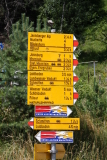
Which way now for the K78s?
If you don't know Bergün, and you don't, you are really missing out. It's a truly lovely village, 1367m up, with narrow, cobbled streets which twist, rise and fall between quaint old buildings; a church sits above on a rocky outcrop, meadows and streams surround it, and the colossal Piz Ela dwarfs it. It also has two odd little municipal buildings where we K42s were marshalled after hopping off the train. There was a good hour or so to wander about, getting the atmosphere and turning nerves to adrenalin, and we had the privilege of seeing the leaders in the K78 come through the town with 39km completed, a wave of noise echoing along the main street each time; a Finn, Anssi Raittila, led the way, but something about him told me he wouldn't lead after the mountains. Then Swede Jonas Buud, last year's winner; a crazily-smiling Swiss, Konrad Von Allmen; soon after, Cheshire's ultra-running legend and twice K78 champion Lizzy Hawker leading the women. A genuine privilege to see those guys do their thing.
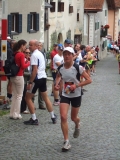
Lizzy Hawker in Bergün
I drained a couple of sports drinks, forced down some scraps of food and headed with Carmel to the start area in a meadow outside town to focus my thoughts and try to relax. From endless worried analysis of the course profile, I'd decided that the race could be broken down into five chunks; a steady climb of 500m over the first 10km - tough but runnable, with restraint needed; another 800m climbing to the first pass, but this time steep - walk most or all; a downhill, 450m drop; the second steep climb, 400m high, also a definite walk; finally the long sweep downhill to the finish, 1000m of glorious gravity pay-back helping me to keep moving over the final 17km.
A final short jog told me that the terrible stiffness from several days of not-really-very-sensible (but great fun anyway) mountain hiking had eased sufficiently. Time to go. A last wave to Carmel, a final heart flutter, and off.
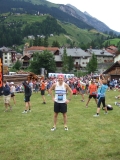
Help me!
The first couple of kilometres was a lap of the village, up and down through fields and woods, patiently warming up before pitching up from the race's lowest point, along the festive, uplifting (in two senses) main street and off towards the Val Tuors, or Tuors Valley if you like. A quick cultural aside - Bergün's official double name, Bergün/Bravuogn, is a clue that it's on the fringes of the region where Switzerland's smallest official language, Romansch, is spoken; a kind-of messy collision between Swiss-German and Italian - hence Val, not Tal, I expect. You get the idea of the sort of nonsense a chap uses to distract himself in this sort of sticky situation.
Anyway, the climb towards the head of the valley started with a nice, steady incline which could be run without too much punishment, and I was nicely warmed up by the time the route started playing with us, kicking up off-road to cut off a double-hairpin, or just undulating with the geology. Chances were taken to walk the steepest parts - after all, it was going to be a long day. A very long day. Curiously, chatter was almost absent amongst the runners - unusual for a long race before the real hard work starts. Foreboding, perhaps? The crowd support was understandably sporadic but very enthusiastic. The race organisers had printed our names on the race numbers, and the spectators made full use of them. The 'Hopp! Hopp!' cries were familiar from last year, and 'Superrrrr!' too, but 'Heia!' was a new one to me - curious.
I'd budgeted an hour and a half to complete the ten-kilometre climb up to Chants, a mixture of smart newer houses and rustic wooden farms at the head of the valley where the roads run out, and I was surprised to find I'd done it in under an hour and ten. The Swiss love hiking, and even the remotest tundra is criss-crossed by trails marked by bright yellow signposts and populated by walking-pole-toting Swiss of all ages and all shapes. Chants looks like hiker paradise. It's also the place where I first had vegetable soup during a race. Given what was to come, I reasoned that (a) I would need calories and (b) I'd be walking for the next hour-plus, so what the hell. Alpinbrötli (currant buns) and bananas were taken on board too. Thinking head? Check. A short way out of Chants, the trail started to get nasty.
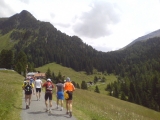
Chants
Nasty in terms of incline, but breathtakingly spectacular in terms of scenery. And to be honest, it's way easier to walk up briskly than to run up very slowly. We wound our way up through the woods towards the alpine-flower-strewn high pastures. It felt good. It was hard hiking, but the clean air was intoxicating. From time to time I passed K78s, identified by their red numbers and grey faces, sitting by the trail recovering. Hopp, Stefan. Hopp, Gerhard. A Very Long Day. I'd calculated that it would be about an hour and a quarter of un-runnable climb before we reached the top, 800m above. Trees gave way to low shrubs, which gave way to boulders and jagged rock. The Porchabella glacier came into view beneath the hard, grey summit of Piz Kesch, and the warmth of the lower levels was replaced by a slight, and welcome, chill.
We passed many walkers on the way up from Chants, and the encouragement from them was awe-inspiring. And I'd swear that half of them were just out on their Saturday hike in that remote wilderness, and each yielded the rough path willingly in favour of the treacherous footing at the side without a hint of complaint or exasperation. Thanks, all.
After a strangely enjoyable 45 minutes or so, I caught my first glimpse of the race's high point. The Keschhütte (literally 'Kesch Hut') is as close to a miracle as I've seen lately, a modern, four-storey hiking hut perched on a mountain pass at 2632m, and a shade over 15km into the race. As far as I can tell, there's no way of getting to the Keschhütte except on foot (the signpost back at Chants says 2½ hours, though we halved that) or by helicopter. Yet there it is. Had I been in a more distressed physical condition, and had I not expected it, I would have thought I was hallucinating and had a nice sit-down. Instead I croaked (audibly) 'Yay! Keschhütte!', or something similarly lame, and cracked on with what vigour I could summon. It was still a long way up.
It had been bugging me for ages, since Tuors Devant, I think, but on the rocky trail below the Keschhütte, I finally remembered the German word for 'difficult'. It's 'schwer'.
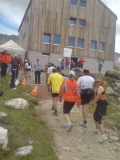 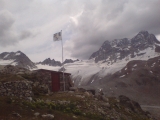
The Keschhütte; Porchabella Glacier and Piz Kesch
As we rolled into the Keschhütte, we were met by a pair of medics who stopped everyone in turn, looked into their eyes and asked if they were lucid. I said 'OK', mainly because Jeremy the Enchanted Badger told me to, but I actually did feel good anyway. The support was boisterous, and the thin air made my heart pound. There was a chip timing mat in front of the hut. I wasn't surprised, really. But the jazz band and the clutch of merry spectators enjoying a cool half-litre of Monsteiner from the bar did make me wonder. My watch told me I'd taken the expected 75 minutes from Chants, and so was a good fifteen minutes up on my optimistic timetable, never mind the pessimistic one. More grub, more liquids, a moment to recover and a lingering look down the route. Then off down the Val Funtauna. Part three of the race, and one to remember.

Val Funtauna
The way down from the top was as rough as the way up had been. For a while, we picked our way cautiously from boulder to boulder, afraid to let go and run, but after a bit, things got more forgiving. Mostly single file, overtaking was done by yelling 'Achtung links!' or 'Achtung rechts!' (an old skiing technique, and anyway, I don't know the German for 'Track!'), hopping off onto the rough stuff and saying a silent prayer. I was pleased to discover that I had some kind of aptitude for downhilling in these circumstances (gravity is not usually my friend), and gained dozens of places. Going down is very different from going up, and is very hard on the knees, but still, it was a joy. The Val Funtauna is starkly beautiful, reminiscent of the most deserted of Highland glens, so it seemed somehow natural to pass a bagpiper stood on a pathside boulder. Bravo, that man. At one point, the K78s got their one and only merciful break of the whole day, and were diverted along the high side of the valley on the Panorama Trail, staying fairly level whilst we K42s descended to climb again. As we neared the flatter, greener trails of the lower part near 20km, the need to concentrate on painfully careful foot placement became less onerous, and running became (and not with hind-sight; I made a mental note of this at the time) as good as it gets. I mean ever.
Thump.
What the hell....? I'd hit the ground pretty hard. My foot had caught something unseen, and I'd landed with some force, doing a somersault and coming to rest before I'd known anything about it. My left calf had cramped sharply, my left knee and shoulder had taken a whack, but I'd somehow executed a perfect judo roll and, once the shock was over, I found I was absolutely fine. I'd landed on turf, avoided the rocks with my noggin, and I was absolutely fine. No helicopter evacuation for me, despite what the chap behind must have thought. I gasped to him that I was OK and carried on. I worried a little about the calf, which hadn't completely let go yet, and noted the sting and warm trickle of a grazed knee, and maybe took it a little bit more carefully from there...
Maybe I'd left a little tuft of stuffing behind when I fell; fatigue began as I neared the feed station at Alp Funtauna, a remote farm building at the valley bottom, still 2200m above sea level. Rising straight up from it was the path up to the Scaletta Pass, shorter than the Keschhütte attack but steeper, a 400m haul which I'd bargained on taking 45 minutes.
I was starting to struggle.
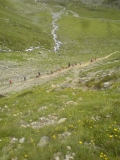
The ascent of the Scaletta Pass
This climb does a lot of snaking, and the rows of runners draped around the hillside like bunting were an impressive sight. I needed to rest for a few seconds every once in a while, and I felt very tired. By the time I'd reached the snow-filled hollows near the top, it was getting obvious that I was hungry and dehydrated. There wasn't much joy in the scenery, nor relief from the upward trudging. The K78s crossed the snow to rejoin us, almost in sight of the top, and after another lifetime or two, I reached the Scaletta Pass. You might think, from the name, that people use this place as a means of getting from one valley to another. Perhaps they do, but it's more of a col than a pass, if my geography serves. Yes, anyone daft enough to want to go over this mountain would choose the Scaletta Pass rather than the peaks either side, but it's a damn close call.
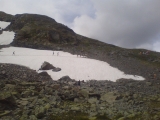
The K78s join us from the Panorama Trail
Mind you, there was a lot going on at the Scaletta Pass. No fancy high-rise hut, just an old wooden one, but a marquee with hot drinks, cold drinks and plenty of food. There was also a set of stretchers with a team of young masseuses tending to a chap's every need, though for some reason the blokes on those stretchers seemed reluctant to let anyone else have a go. And there was a helicopter buzzing back and forth to supply the camp with food, drink, young masseuses and so forth. I stumbled in, tired, hungry, thirsty and worryingly light-headed. It would be a very good idea to have a proper break here. I took three drinks (one a hot lemon tea, strangely) and some food, and resolved to sit consuming them for a good ten minutes.
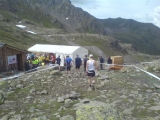
The Scaletta Pass
I was off after seven, feeling better and optimistic about the nearly all-downhill last 17km. I'd got in with the clock at 3:50, having passed 25km at the top of the climb. My last 5km had taken an hour, but I was well ahead of schedule. Remembering the course details, it would be a steep descent to Dürrboden, at the head of the Dischmatal (Dischma Valley) where the road re-appeared and Carmel had hoped to be, and I wanted to get there.
Unfortunately, the descent was trickier than that from the Keschhütte. It was painful, painstaking going, that track, and there was little chance of running freely for a long time. I skipped and hopped as lightly as I could from rock to rock, scanning for trouble and easier footing, but it was seriously no fun. Suddenly, I found myself catapulted down the track. I'd turned my right ankle on god-knows-what, and had lost my balance completely. No nice turf to hit here, all rock. I careered towards the runner in front, somehow brushed past him without knocking him flying too, and regained control. I apologised profusely - it's one thing hurting myself, taking out someone else is another thing altogether, and it could have been nasty. Injury inspection; turned ankle, hurting. As bad as the left ankle on the North Downs 30K? No. OK, press on then. And bloody take care!
A couple of days later, I discovered that a chap from Milton Keynes AC had fallen ten metres on the descent of the Scaletta Pass and fractured his skull.
In time, the path levelled out, and the going became good. The Dischmatal runs for about ten miles from Davos towards the Scaletta Pass, but the road runs out at Dürrboden, a cluster of buildings where weary hikers can get their last meal before hitting the wilderness (or their first one after). A sizeable collection of supporters had made their way there from the town by bus and a shuttle minibus, and after trotting over a dinky footbridge into the farmyard-esque cluster of buildings, I spotted Carmel, as promised. So glad, so glad. I grabbed a bit of banana and a drink and made for the barrier tape. Carmel seemed genuinely surprised to see me; I would have expected to be up at the Scaletta Pass at that time, and she'd only just got to Dürrboden. I gleefully talked her through my slightly clarety knee and (once it was pointed out to me) the filth up my left arm, generally trying to seem as hardcore and manly as possible (for a person wearing a Swiss flag bandana at least) and headed off. I grabbed a second bit of banana and more drink and returned to the sidelines for more chat and dawdling - Carmel strove brilliantly to conceal any disapproval and, with quick-witted psychology assured me that I could break six hours easily if I get a move on. How far? About eight miles? How long does that take? Not long, apparently. Off you go, downhill all the way, see you at the stadium. 4:24 on the clock.
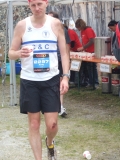
Dürrboden - a real Englishman always stops for Tea
Dischmatal proper. The valley is a broad, sweeping thing, a classic glacial one, with the odd farmhouse here and there. We were kept off the tarmac road, mixing firm stony footpath and newly-mown meadow as we headed for Davos. I hadn't held any illusions about it; the gentle decline of the valley would certainly be no match for my declining legs come the last ten kilometres, and it wasn't. The pretty pastures and ever-encouraging people were gladdening, but the odd slight uphills couldn't be conquered in any positive way, and brief walk breaks were allowed. 'Heia!' had largely given way to 'Hopp!' by now (had the Romansch influence faded? And, actually, did I care?), but, increasingly, you needed to be jogging along happily to get a cheer; otherwise you just got a pitying look. I mean, come on! I've just crossed two stupid alpine passes and you won't give me a 'Hopp!' 'cos I'm walking this bit?
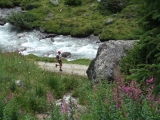
Dischmatal
I'd done the maths, and frankly, unless I could get my running legs back, I wasn't going to make it in under six. No big deal really, six and a half was the original schedule, but it's always so annoying when any nice round number taunts you when your legs are going. I did my best to kick on, but could only sustain proper spells of good running on the downhills. Carmel popped up serendipitously at Teufi, and got a wan, sorry, hurty half-smile in return. The K78s' 70km marker, our 35 and their 75 passed in an eternity, and the equation became less and less favourable, but the end would come soon and I could stop soon. I could collapse on the astroturf with my alcohol-free beer soon and that shiny, shiny medal. Soon, soon. Keep going, keep going.
The Dischmatal opens out into the Landwasser valley at Duchlisage. I remembered Duchlisage from last year; we were re-joining the K21 route as it skirted round Davos. The K21s themselves had passed by, but the Nordic walk event was in full swing, and the competitors clack-clack-clacked their walking poles up the street towards us. We converged and headed up into the woods.
This was the final little trick the race would play on us, but it was no surprise; a mercifully short but sharp dig up into the trees that skirt Davos. This late in the day, it felt like I was in the Death Zone on the upper slopes of K2, and the effort was exquisite agony as my heart stalled and spluttered. Grumpy, grumpy, push on, keep it moving. Stupid race. Flattish woodland next - very pretty, didn't care. Passing walkers was harder than it should really be for someone supposedly running, and the odd novice Nordic wafted their poles at eye level on the uphills. The 40km marker came and went and - hang on - five hours, 41 and a bit, and it's only two-and-a-bit to go - sub-six was a cert if I could keep up a slow jog.
When you need to slow-jog, it helps to have a respectable downhill, and an obliging slope carried us out of the shaded forest into the daylight and bustle of central Davos. And when mountains, cows and suffering have been your companions for so long, it's all quite terrifying to turn into the noisy, festive final straight, but it sure as hell makes you pick up your tempo. No-one wants to see a filthy, sweaty, slumped, tearful shuffler - they're here to cheer sleek, confident, prancing alpine über-athletes. So I set about it, trying to acknowledge the encouragement with a smile and a sprightly step.
Through the groundsman's entrance onto the vivid orange running track at the Sportzentrum. The announcer gabbled on. I prayed that he wouldn't be calling out names; no-one's eyes should look upon my hideous physical condition. The final bend: K78s coned off to the outside lane, riff-raff hugging the racing line, over the timing mat and under the inflatable arch, stop, double over, hands on knees, brief but intensely heart-felt foul, awful language, binding pact with myself never, ever to do the Ultra version, and... that was it. Five hours, fifty-three minutes and twelve seconds, all done.
A teenager armed with cutters snipped off my timing chip (fortunately; I would never have reached), and I sought out my medal. The medal I'd somehow convinced myself would make everything worthwhile. I think it did. It was shiny and big, it was red-black-and-sort-of-gold, chunky, on a red ribbon with a Swiss-flag motif. I liked it.
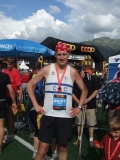
First aid, please
Carmel tracked me down in the throng, parked me on the infield and looked after me as she always does (my bag was up a flight of stairs and I didn't want to leave it in Davos). Hopefully she'd be repaired soon, and we could race here another time; we'd be married by then. We drank Erdinger Alkoholfrei on the astroturf again. They were giving out the big prizes on the podium. Buud, the K78 champion, had won again; the Finn had faded in the high mountains. And Hawker had been deposed by Jasmin Nunige, a Davoser. I hadn't won anything, as they don't give special awards for being barely mediocre, but I was quite proud anyway.
No, very proud. It had been a long day.
|
|